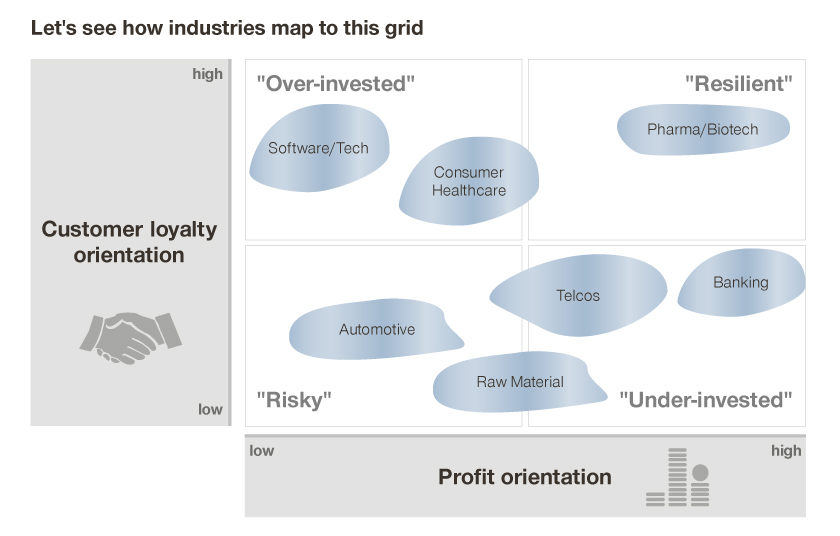Business resilience is a company’s ability to adapt to disruptions: keeping operations running, while safeguarding resources and brand equity. In this article, we explain how to develop business resilience on two fronts: profit orientation and customer loyalty orientation.
Since the coronavirus crisis, there have been numerous prominent examples of companies filing for bankruptcy, spanning across countries and industry verticals. It ranged from North America to Asia, from entertainment to engineering, and even in some more resilient industries such as communications. You might initially blame demand that suddenly and severely broke away in these industries. However, there is one factor all these companies had in common, and that is inadequate profit orientation. No company has ever gone bankrupt from making profits.
Profit orientation is a core dimension of economic business resilience. The other dimension is an orientation toward customer loyalty. Today, the economy is increasingly defined by a customer-led market. Therefore, it is crucial for companies to think through the customer life cycle and provide value at every step.
This crisis that then led to inflation is an ongoing stress-test for companies’ economic model. Yet, despite tough times and dwindling demand, there will be successful companies that emerge as winners. The secret to success? Business resilience. Resilient companies not only have a loyal customer base, but their revenue model also extracts value and profitability from customers.
What are the levels of business resilience?
When consultants talk about the two dimensions, you know what's coming: a matrix. In one of our webinars, we asked company leaders to assess their company based on their customer loyalty orientation and profit orientation. The results showed varying levels of business resilience:

- Over invested. 25 percent of respondents considered their companies to be very customer loyalty-oriented, but not very profit-oriented. For example, software and tech companies can become over invested from all angles. They invest in acquiring and retaining customers. But if you ask them about profit, you usually get the answer: “That's the next step for us.”
- Under invested. 29 percent of respondents saw their companies as very profit-oriented, but not very customer loyalty-oriented. These businesses tend to generate good profits thanks to the heritage and quality of their products. But they still have a way to go in terms of locking their customers in.
- Risky. There’s a significant risk in being neither customer-loyalty-oriented nor profit-oriented. That’s how 18 percent of respondents assessed their company. Here, market share usually trumps profit. It can also be difficult to connect the loyalty dots if the business is built around one-time transactions and selling indirectly to the customer. That can happen, for example, in the automotive industry.
- Resilient. The most successful companies build a loyal customer base. They grow their margins with product innovation and new revenue models. The good news is that there are some companies already here. 29 percent of respondents saw their company as having a strong orientation toward customer loyalty AND profits. The challenge is to stay there at the top.
How does your company perform in terms of resilience?
For all industries there are single companies positioned in a very different way. Think about your business and your levels of customer loyalty orientation and profit orientation.
Apple’s recipe for success
A company that has achieved resilience is Apple. It was a profitable hardware manufacturer for 34 years, selling in a transactional way. Only in the last 10 years has the company moved toward services and software. It was a new business area, which also meant totally new revenue models.
Apple’s combination of selling profitable, transactional hardware plus even more profitable recurrent software services has shaped its success story. New services account for approximately 20 percent of Apple sales today, with much higher profits than from traditional hardware.
Your first reaction to the example above might be “not Apple again” or “my business is nothing like Apple.” But Apple is not the only company that is both profit and customer loyalty oriented. There are other companies that have successfully transformed their business. For example, tech giants like Amazon moved to web services, and Microsoft implemented its intelligent cloud.
There are also traditional, industrial companies that have moved into new growth areas. Some of the examples are Siemen’s Digital Factory initiative and Schneider Electric’s IoT-enabled solutions. Today, these new areas, often based on a recurrent revenue model, account for a big chunk of their sales.
Four key lessons from profit-oriented companies
1. They instill a profit mindset
That means focusing on profit over market share, emphasizing cash flow, and managing costs. In our experience, companies lacking profit orientation typically focus on market share or volume growth. Meanwhile, resilient companies target specific profit KPIs, such as the net retention rate and recurring revenue rate.
Effective business resilience can take place if top managers know the revenue targets and actuals. They also can readily quote you their profit numbers in any meeting. Sales people carefully consider profit impact when making a deal. Everyone at all levels always has a clear and current view on the company’s profit situation.
2. They protect the core business
It’s easy to say we want to be Apple. We need profitable products that everybody loves and values. But what steps are you taking to ensure your core offering is and remains attractive in the eyes of the customer?
Business resilience requires regular company investment and sensors on the market. This ensures you build products around the price, and not the other way around. Managers should also be aware of low and unprofitable products and services. They conduct constant reviews and discipline measures to cease any offerings that fail to meet their profitability targets.
3. They protect their prices
Under business resilience, companies know that price is by far the most important profit driver. They understand that achieving price generates profits, defending price protects them, and cutting prices (without costs) damages them. That’s why resilient businesses are equipped with data before any price move.
Resilient businesses simulate the impact on customers, the market, and competitors. They understand cannibalization effects, make differentiated price moves, and ensure price increases are properly enforced. Even when they have to give discounts or run promotions, they still defend profitability by first making “smart concessions”. These add another layer of value or ask for something in return, rather than immediately attacking price.
4. They eliminate cross-subsidization
Business resilience requires companies to be rigorous when it comes to cross-subsidization between products and business units. To axe the unprofitable, this the discipline must be strict.
There may be strategic cases where they decide to go in at a loss with some customers or products. But they ensure the whole package is net positive and comes with a beautiful bottom line. Not every product or customer can be strategic. Only maintain those on a clear pathway to profitability.
How to turn one-time customers into loyal ones
Albert Einstein was asked to name the most powerful force in the universe. He thought for a minute, and then replied. “Compound interest is the eighth wonder of the world. He who understands it, earns it; he who doesn’t, pays it.”
It is certainly true that compound growth is one of the most powerful forces that a business can harness. However, many companies find themselves on the wrong side of the equation.
They are unable to bring customers back or get more money from their existing customers. Eventually, they find themselves in a position where they must acquire and acquire to acquire. They're constantly bailing water on their metaphorical ship at sea.
In contrast, the companies that benefit from compound growth have positive net retention. It means that every year the same group of customers generates more and more income. These businesses can shut their doors to any new customers and not only be profitable, but also grow.
Now, you may say that's only true for tech companies, subscriptions, and SaaS. But there are many businesses with repeat customers. Think about fast-moving consumer goods. Even if purchases are transactional in nature, a customer loyalty orientation can generate recurring revenue.
Let’s bring this to life with a case study.
What is an example of customer loyalty?
Before becoming a Partner at Simon-Kucher, Eddie Hartman founded LegalZoom. It is an online legal technology company which provides services for small businesses and individuals. Hartman explains how LegalZoom began with an exclusive focus on "transactions". But it moved to recurring revenue after studying customer needs was able to change the internal mindset:
In the early years at LegalZoom, we had it all wrong. We assumed that most of the value provided, and the revenue realized, would be generated during the initial purchase. They had their trademark filed. Their patent application was on the way. Their entity had been formed, etc.
We tried to capitalize on the initial transaction with a “good, better, best” structure, differentiated by speed and support levels. We thought that a customer would come to us to support with a legal service, then not want to hear from us again. However, once we started mapping customer needs, we saw customers wanted something very different…
The formation of a business is the start, not the end, of a customer’s legal problems. They must worry about tax, finance, regulations, compliance issues, employee agreements, etc. There is a multitude of paperwork tasks that customers associate with law and where they need support.
Wouldn't you want the company that started your business to continue to help you? LegalZoom today developed business resilience thanks to its focus on recurring revenue. It helped customers at every step of their entire legal journey.
You might be thinking that this doesn't apply to your business. You may be in an industry that “couldn't ever” get a subscription. Or your situation is so once-in-a-lifetime that it’s “impossible” to generate recurring revenue. But try telling that to LegalZoom. After all, what could be more once in a lifetime or resistant to a recurring revenue model than divorce?
Business resilience and the direct road to profitability
Achieve both customer loyalty orientation and profit orientation, and you’ve got business resilience. Entire new industries have sprung up through this mindset. They succeed because their products are in line with customer needs. They tap into willingness to pay and take them on a direct road to profitability.
It’s easy to say for a tech company, where there’s profits to be had. But what if your entire sector is under threat?
Think about neighboring business areas. We’ve seen successful automotive suppliers offer battery charging, and industrial companies provide digital solutions. A move to a recurring revenue model can also be made through servitization, such as monetization of data. Even if your whole business is breaking away, you will need to find something in a new space. But you will have to develop that business resilience from the very beginning.








